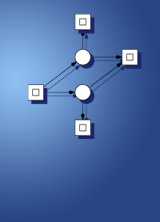
research
data structures and software dependability
computer science department
brandenburg university of technology cottbus - senftenberg
research - Overview of main research areas
latest update: April 21, 2021, at 08:30 AM
For an article of how everything began and developed over the years, see
- [H19]
M Heiner:
Petri Nets for BioModel Engineering: A Personal Perspective;
In Carl Adam Petri: Ideas, Personality, Impact, (W Reisig and G Rozenberg, Eds.), Springer, Cham, pages 205–216, 2019 (first online 25 May 2019). [ url ] [ doi ] [ BibTeX ]
For a feature of our Petri net related research, Courtesy of International Innovation – a leading scientific dissemination service, see
- [H14-feature]
Research Media:
The power of Petri nets;
In International Innovation, Special Focus - Women in Healthcare, Research Media, volume 137, pages 72-74, May 2014. [ url ] [ pdf ] [ BibTeX ]
For a summary of our Petri net related research profile, see
- [H14]
M Heiner:
Petri Nets Research at BTU in Cottbus, Germany;
In Petri Net Newsletter, GI, Newsletter of the Special Interest Group on Petri Nets and Related System Models, ISSN 0391-1804, volume 83, pages 19-25, April 2014. [ pdf ] [ BibTeX ]
Software Dependability Engineering
vision
- constructive and analytical methods to develop dependable software-based systems;
- see also former project Certifiable logic programmable controller;
related courses
- “Software Dependability”
- “Software Testing”
- “Introduction into concurrency”
- “Modelling and Analysis of Concurrent Systems using Petri Nets”
Petri Nets
vision
- a general Petri net framework incorporating various net classes and related tools
- see also project Petri net workbench;
related courses
- “Introduction into concurrency”
- “Modelling and Analysis of Concurrent Systems using Petri Nets”
Computational Biology
vision
- computational methods in systems and synthetic biology
- methods and tools to model and evaluate (by analysis, simualtion, animation) biochemical networks, comprising qualitative as well as quantitative approaches, specifically stochastic, continuous and hybrid Petri nets;
- see also project Computational methods in systems biology;
related courses
- “Modelling and Analysis of Concurrent Systems using Petri Nets”